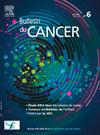Ostéosarcome et sarcome d’Ewing récurrents ou réfractaires – Directives françaises des groupes FSG/NETSARC et GroupOs
IF 0.8
4区 医学
Q4 ONCOLOGY
引用次数: 0
Abstract
Les ostéosarcomes et les sarcomes d’Ewing sont les deux tumeurs osseuses malignes les plus fréquentes chez les enfants, adolescents et jeunes adultes. En cas de récidive de la maladie, le taux de survie globale est faible, avec uniquement environ un tiers des patients ayant une survie à long terme sans maladie. En cas de maladie récurrente ou réfractaire la stratégie thérapeutique doit être discutée lors de réunions multidisciplinaires avec expertise dans la prise en charge des sarcomes osseux. La prise en charge des patients avec un ostéosarcome récurrent ou réfractaire dépend de l’intervalle sans maladie ainsi que du nombre et des sites des métastases et est principalement chirurgicale chez les patients présentant des métastases pulmonaires isolées ou une rechute locale. D’autre part, la chimiothérapie conventionnelle reste la norme pour les patients avec un sarcome d’Ewing récurrent ou réfractaire et comprend l’ifosfamide à haute dose, le cyclophosphamide avec le topotécan et l’irinotécan avec le témozolomide.
Osteosarcoma (OS) and Ewing Sarcoma (ES) are the two most frequent malignant bone tumors in children, adolescents and young adults. In case of disease recurrence, both are characterized by an aggressive behaviour and a relatively poor overall survival rate, with approximately a third of patients having a long-term disease-free survival. In case of recurrent or refractory (R/R) disease, the therapeutic strategy should be discussed in multidisciplinary staff meetings with expertise in bone sarcoma management. The standard management of R/R OS depends on the disease-free interval and the number and sites of metastases and is primarily surgical in patients with isolated lung metastases or local relapse. On the other hand, conventional chemotherapy remains the standard for R/R ES and include high-dose ifosfamide, cyclophosphamide with topotecan and irinotecan with temozolomide.
[复发性或难治性骨肉瘤和尤文氏肉瘤- FSG/NETSARC和GroupOs组的法国指南]。
骨肉瘤(Osteosarcoma, OS)和尤文氏肉瘤(Ewing Sarcoma, ES)是儿童、青少年和年轻人最常见的两种恶性骨肿瘤。在疾病复发的情况下,两者的特点都是攻击性行为和相对较差的总体存活率,大约三分之一的患者长期无病生存。如果复发或难治性(R/R)疾病,治疗策略应在骨肉瘤管理专业的多学科工作人员会议上讨论。R/R OS的标准治疗取决于无病间隔、转移的数量和部位,对孤立性肺转移或局部复发的患者主要采用手术治疗。另一方面,常规化疗仍然是R/R ES的标准,包括大剂量异环磷酰胺、环磷酰胺与拓扑替康和伊立替康与替莫唑胺。
本文章由计算机程序翻译,如有差异,请以英文原文为准。
求助全文
约1分钟内获得全文
求助全文
来源期刊

Bulletin Du Cancer
医学-肿瘤学
CiteScore
1.90
自引率
16.70%
发文量
224
审稿时长
37 days
期刊介绍:
Without doubt, the ''Bulletin du Cancer'' is the French language publication of reference in the field of cancerology. Official organ of the French Society of Cancer, this journal covers all the information available, whether in the form of original articles or review articles, but also clinical cases and letters to the editor, including various disciplines as onco-hematology, solids tumors, medical oncology, pharmacology, epidemiology, biology as well as fundamental research in cancerology. The journal proposes a clinical and therapeutic approach of high scientific standard and regular updates in knowledge are thus made possible. Articles can be submitted in French or English.
 求助内容:
求助内容: 应助结果提醒方式:
应助结果提醒方式:


